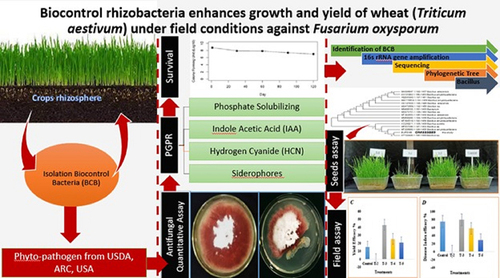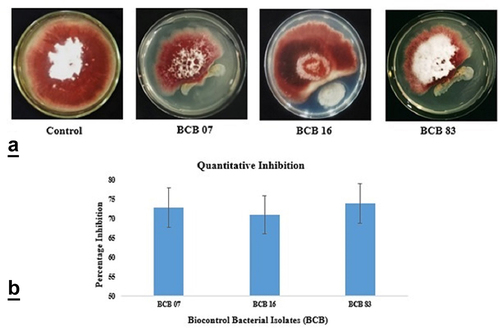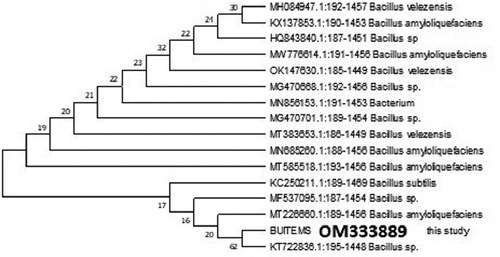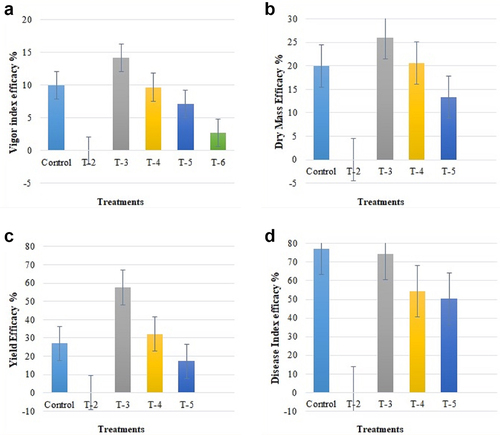Figures & data

Figure 1. The antifungal activity of selected isolated strains a) qualitative assay of biocontrol isolates against F. oxysporum; b) graphical representation of a quantitative biocontrol isolate inhibiting F. oxysporum by at least 70%. All experiments were carried out in triplicate. (BCB07: Bacillus velezensis), (BCB16: Bacillus amyloliquefaciens) and (BCB83: Bacillus subtilis).

Table 1. Plant growth-promoting activity of the selected biocontrol isolates. PS: phosphate solubilization; IAA: indole 3-acetic acid; HCN: hydrogen cyanide. Positive activity is shown by (+) sign and negative activity by (-) sign.
Figure 2. The biocontrol isolates’ hydrolytic enzyme activity. a) isolates’ cellulose hydrolyzing activity in CMC agar medium. b) the isolates’ protease activity in skim milk agar medium (BCB07: Bacillus velezensis), (BCB16: Bacillus amyloliquefaciens) and (BCB83: Bacillus subtilis).

Figure 3. Phylogenetic cladogram constructed using MEGA X. Neighboring joining method with 1000 replicates were used to construct boot strap tree. (supplementary figure of Mega X file attached).

Figure 4. The survival of BCB16 in talc powder. X-axis shows the number of days while Y-axis represent the colony forming unit (CFU) in log.

Figure 5. a. Seed germination (wheat cv. Zarlasht). (T-1) seed treated with strain BCB16; (T-2) seeds treated with phytopathogen F.Oxysporum spores; (T-3) seeds treated with strain BCB16 and F. oxysporum; (control) seeds treated with sterile distilled water. b) (i)vigor index; (ii) fresh weight and dry mass; (iii) leaves and root numbers; (iv) disease index; (v) mean efficacy. Letter on the bar indicate significance differences between treatments using analysis of variance (ANOVA) and subsequently by Duncan’s multiple range test at p < 0.05.

Figure 6. Pathogenicity test of effect of Fusarium oxysporum on wheat cv. Zarlasht. a) control wheat plants without fungus treatment and b) pathogen (F.Oxysporum) at 106 spores/ml treated plants.

Table 2. The data after pathogenicity test was analyzed statistically by applying one-way ANOVA, average values of each treatment. Significance was evaluated to compare significance, through Duncan test. Different letters indicate significant difference among the groups (control vs fungus treated).
Figure 7. The efficacy of biocontrol bacteria (BCB16) against phytopathogenic fungi in a field trial. (a) efficacy of vigor index; (b) efficacy of dry mass; (c) yield efficacy and (d) disease index efficacy. The experiments is performed in triplicate.

Table 3. Field data from BCB16 on wheat crops against F. oxysporum show a significant reduction in disease index when compared to the positive control. The similarity of the letters between the groups indicates a non-significant difference.
Data availability statement
The authors confirm that the data supporting the findings of this study are available within the article [and/or] its supplementary materials and the accession number of bacterial strain available in Genbank.
